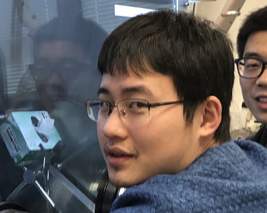• RMIT–UNSW collaboration combines theory, experimental expertise
• ‘Spintronic’ applications promise faster, more efficient computing
• New magnetic properties of 2D Fe3GeTe2 (FGT) discovered
A theoretical–experimental collaboration across two FLEET nodes has discovered new magnetic properties within 2D structures, with exciting potential for researchers in the emerging field of ‘spintronics’.
Spintronic devices use a quantum property known as ‘spin’, in addition to the electronic charge of conventional electronics.
Spintronics thus promise ultra-high speed low-energy electronic devices with significantly enhanced functionality.

Spintronic devices use a quantum property known as ‘spin’, in addition to the electronic ‘charge‘ used in conventional electronics.
A single ‘bit’ of a conventional device can take two states: represented as 0 and 1. The computing power of conventional electronics thus increases by 2 to the power of the number of bits (2n). One bit: two states, two bits = four states, three bits = eight states, a thousand bits = 10300 states.
In comparison, a single ‘bit’ of a spintronic device has four states: 0-spin up, 0-spin down, 1-spin up, 1-spin down. Its power thus increases by four to the power of the number of bits (4n). One bit: four states, two bits = 16 states, three bits = 64 states, a thousand bits = 10600 states.
The RMIT–UNSW study discovered never-before-seen magnetic properties in devices known as vdW hetero-structures comprising several layers of novel, 2D materials.
The latest results show that vdW spintronics could provide devices with more functionality, comparing with the traditional spintronic approaches. Further research could generate devices with significant industrial applications.
Background
Two-dimensional (2D) ferromagnetic van-der-Waals (vdW) materials have recently emerged as effective building blocks for a new generation of ‘spintronic’ devices.
When layered with non-magnetic vdW materials, such as graphene and/or topological insulators, vdW hetero-structures can be assembled to provide otherwise unattainable device structures and functionalities.
The material studied was 2D Fe3GeTe2 (FGT), a metal found to display promising ferromagnetic properties for spintronic devices in a previous FLEET study.
Surprising discoveries

We discovered a previously unseen mode of giant magneto-resistance, FLEET PhD and study co-author Sultan Albarakati (RMIT)
“We discovered a previously unseen mode of giant magneto-resistance (GMR) in the material, says FLEET PhD and study co-author Sultan Albarakati.
Unlike the conventional, previously-known two GMR states (ie, high resistance and low resistance) that occur in thin-film hetero-structures, the researchers also measured antisymmetric GMR with an additional, distinct intermediate resistance state.
“This reveals that vdW ferromagnetic hetero-structures exhibit substantially different properties from similar structures,” says Sultan.
This surprising result is contrary to previously held beliefs regarding GMR. It is suggestive of different underlying physical mechanisms in vdW hetero-structures, with potential for improved magnetic information storage.

Co-author, FLEET PHD student Cheng Tan (RMIT)
Theoretical calculations indicate that the three levels of resistance are the result of spin-momentum-locking induced spin-polarised current at the graphite/FGT interface.
“This work has significant interest for researchers in 2D materials, spintronics, and magnetism,” says co-author FLEET PhD Cheng Tan. “It means that ‘traditional’ tunnelling magnetoresistance devices, spin-orbit torque devices and spin transistors may reward re-investigated using similar vdW hetero-structures to reveal similarly surprising characteristics.”
The study
The study ‘Antisymmetric giant magnetoresistance in van der Waals Fe3GeTe2/graphite/Fe3GeTe2 tri-layer heterostructures’ was published in Science Advances this month. (arXiv; DOI 10.1126/sciadv.aaw0409)
As well as support by the Australian Research Council, the authors acknowledge the support of the National Key Research and Development Program (China) and the Institute for Information & Communications Technology Promotion (South Korea).
Collaboration

Definitions
2D materials (also referred to as being ‘atomically thin’) can be as thin as only one single layer of atoms.
Giant magneto-resistance (GMR) is a quantum effect observed in alternating magnetic and non-magnetic layers, commonly used in computer disc storage units.
Spintronics is an emerging field of electronic study in which the ‘spin’ of electrons (their intrinsic angular momentum) is used in addition to their charge.
Van der Waals (vdW) materials are made up of many layers, held together by weak forces. The most well-known vdW material is graphite, with the weak connecting forces allowing layers to ‘shear off’, which is why graphite is effectively used in pencil leads.
VdW hetero-structures comprise a number of different vdW materials, layered on top of each other.
The experiment’s detailed electron transport measurements were performed by a collaboration of researchers led by FLEET CI Prof Lan Wang (RMIT) and FLEET Deputy Director Prof Alex Hamilton (UNSW), using hetero-structures and devices fabricated by Prof Wang’s team at RMIT.
Theoretical studies were led by FLEET CI Dr Dimi Culcer (UNSW), while data analysis was undertaken by teams comprising both RMIT and UNSW researchers.
Electronic band structure calculations were led by Yunjun Zhao at the South China University of Technology (China).
The source study material was synthesised by a team of researchers from the Center for Quantum Materials and Superconductivity (CQMS) and the Chinese Academy of Sciences.
The research was initially conceived and designed by Lan Wang at RMIT.
Nanofabrication at FLEET
VdW hetero-structures are used to study the properties of novel materials at FLEET, an Australian Research Council Centre of Excellence.
The Centre for Future Low-Energy Electronics Technologies (FLEET) is a collaboration of over a hundred researchers, seeking to develop ultra-low energy electronics to face the challenge of energy use in computation, which already consumes 8% of global electricity, and is doubling each decade.
FLEET’s research sits at the very boundary of what is possible in condensed-matter physics. At the nano scale, nanofabrication of functioning devices will be key to the Centre’s success.
Specialised techniques needed to integrate novel atomically-thin, two-dimensional (2D) materials into high-quality, high-performance nano-devices are coordinated within the Centre’s Enabling technology B, led by RMIT’s Lan Wang.
This collaboration between FLEET’s UNSW and RMIT teams is typical of the Centre’s nano-device research, which links many of FLEET’s groups and nodes. Some groups bring expertise in device fabrication, while other groups are strong in device characterisation. Such teamwork, fundamental to modern science, is expedited by the Australian Research Council Centre of Excellence system.
More information
 Contact Lan Wang (experiment; RMIT): lan.wang@rmit.edu.au
Contact Lan Wang (experiment; RMIT): lan.wang@rmit.edu.au- Contact Dimitrie Culcer (theory; UNSW): d.culcer@unsw.edu.au
- Connect at @FLEETCentre
- Visit FLEET.org.au
- Read FLEET Enabling technology B: nano-device fabrication news
- Contact FLEET media@FLEET.org.au
- Watch Future solutions to computation energy use
- Subscribe FLEET.org.au/news



